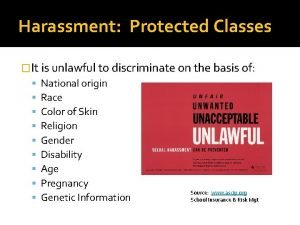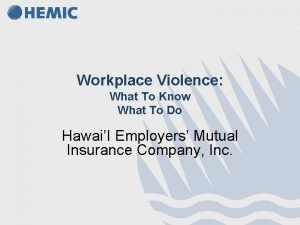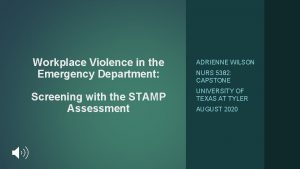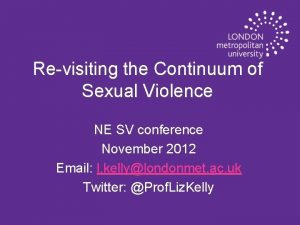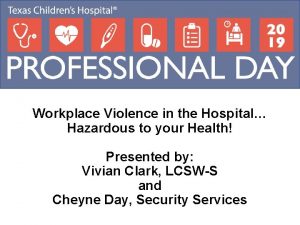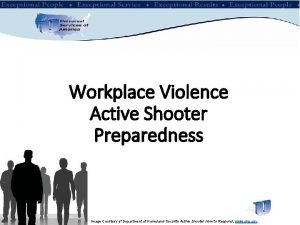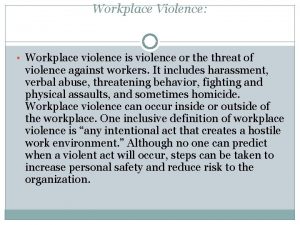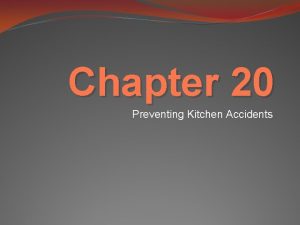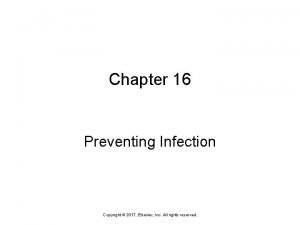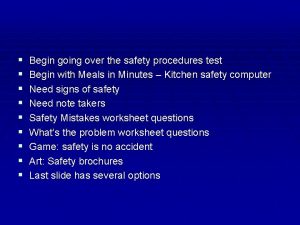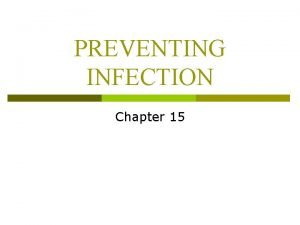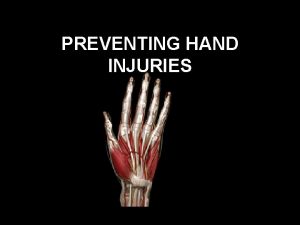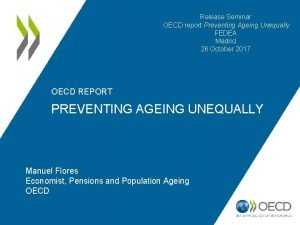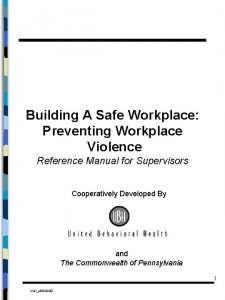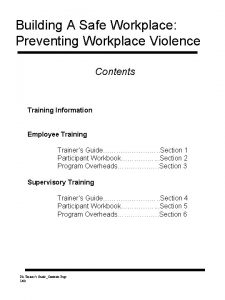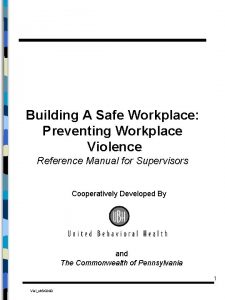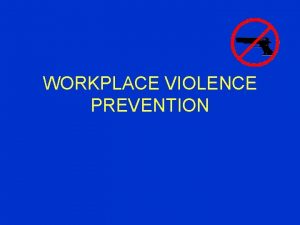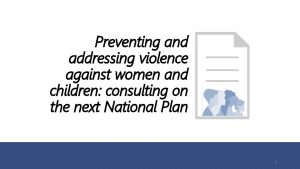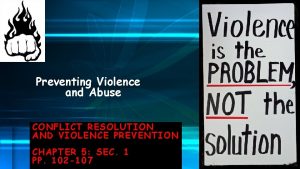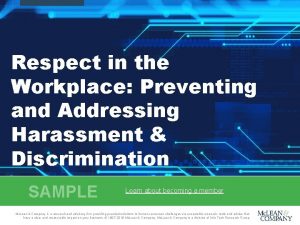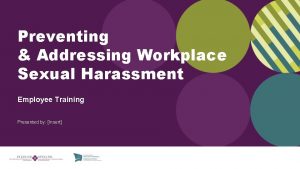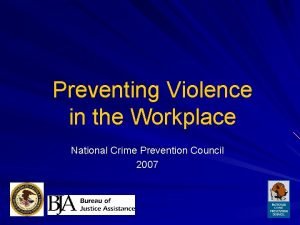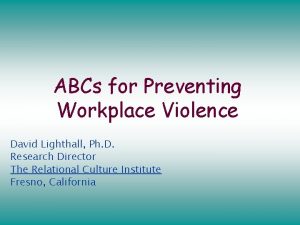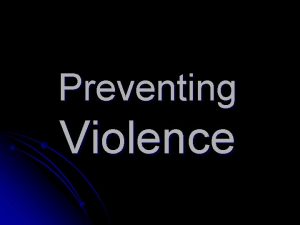Addressing and Preventing Workplace Violence Safe Campus University








































- Slides: 40

Addressing and Preventing Workplace Violence Safe. Campus: University of Washington’s Model Program Kiana Swearingen Training and Communications Specialist Safe. Campus: University of Washington


What is Violence Prevention?

Training Components • • • Threat Assessment Overview Behaviors of Concern & Forms of Violence Safe. Campus Model Case Scenarios Application to your Workplace

Why Should Workplaces Care • Prevent Violence • Create Physically and Emotionally Safe Workplaces • Support Employees • Address Productivity and Safety Impacts of Violence • Economic and Liability Impacts

Threat Assessment & Management • • • Can we predict violence? Focus is on behaviors “Pathway to Violence” Use of Structured Professional Judgment tool Continue to monitor & check in

Behaviors of Concern & Forms of Violence

Behaviors of Concern Behaviors that may mean someone needs support or may be considering harming themselves or others • • • Bullying, Intimidation and Harassment Behaving in an Unpredictable Manner Disproportionate Reactions to the Situation Displacing Blame onto Others Dramatic Changes in Personality, Mood, Behavior Threats toward others

Power based violence affects people from all genders, sexual orientations, races, socioeconomic statuses, abilities, religions, ages, citizen statuses, and other identities. Disproportionality exists in effect rates.

Intimate Partner Violence • 44% of full-time employed adults personally experienced domestic violence's effect in their workplaces • 21% identified themselves as victims of intimate partner violence • Women experiencing physical IPV victimization reported an average of 7. 2 days of work-related lost productivity REF: 1

Intimate Partner Violence Terms: • Domestic Violence • Relationship Violence • Intimate Partner Violence • Dating Violence Power and Control Abuse is an ongoing, purposeful behavior that is aimed at dominating one’s partner, and often one’s children as well What is Coercive Control A pattern of intimate terrorism/behavior which seeks to take away a victim’s liberty or freedom, to strip away their sense of self There is a range of on-going tactics used by perpetrators; emotional, financial, sexual and physical. These can include isolation, degradation, mind-games, and the microregulation of every day.

Intimate Partner Violence Signs • Zero signs • Isolation • Frequent and frantic calls from partner • Partner showing up at work • Post-relationship stalking through technology Socializing differently Performance Changes Missed work Private about relationships • Substance abuse • Sudden financial struggles • Sudden immigration concerns • •

Stalking and Harassment • Over 51% of stalking victims indicated that it had occurred at least once on work premises • 1 in 6 women (16. 2%) and 1 in 19 men (5. 2%) have been victims of stalking. • Individuals under age 25 experience the highest rates of stalking. REF: 1

Stalking • Unwanted or obsessive attention by an individual toward another person • Engaging in a course of conduct directed at a specific person that would cause a reasonable person to – fear for their safety or the safety of others – suffer substantial emotional distress • Can be a known or unknown individual – 61% of female victims and 44% of male victims are stalked by a current or former partner REF: 2

Stalking Behaviors Does not respect boundaries Won’t take no for an answer Harassment in many forms Following/ Showing up where individual is • Sending unwanted gifts • • Stalkers often have “justification” for their actions

Cyber. Stalking • Monitoring e-mails and social media. • Sending e-mails that threaten, insult, or harass • Computer monitoring software; informs of all activities on computer/phone • Using the Internet to seek and compile a victim’s personal information for use in harassment • Using GPS systems to monitor a victims whereabouts

WA State Employee Stalking • https: //www. youtube. com/watc h? v=Jc. M 3 Nef 1 BIQ

What are some of the reasons why survivors might not disclose intimate partner violence and stalking at work?

Suicide • Washington has a 15% higher suicide rate than national average • Middle-aged men, Native Americans and Alaska Natives, trans and veterans of the U. S. armed forces are the highest at-risk groups • WA State Cause of Suicide: – 51% Firearms – 22% Suffocation – 19% Poisoning REF: 3

Suicide Indicators & Response • Experiencing a profound loss • Perceived Burdensomeness • Thwarted Belongingness • Withdrawal from friends/family • • Hopelessness Persistent sad mood Feelings of worthlessness Talking about suicide • Take individuals talking about suicide serious • Asking about suicide will not plant the idea

The Safe. Campus Model

Safe. Campus Model Safe. Campus is UW’s 24/7 violence prevention and response team for UW students, staff and faculty Text slide.

Safe. Campus: How it Works Safe. Campus Receives Call or Email Safe. Campus Offers Support, Resources and Safety Planning Safe. Campus Connects with other Partners Police Human Resources Victim Advocate Employee Assistance Program Community Services

Supporting your Employee Listen. Give them space to talk Be careful to not invalidate their experience/sharing of their situation. • Identify why you are concerned • If they disclose experiencing violence say; “This is not your fault, ” “I believe you” • Focus on safety • Inform them about resources • It may be a process, help support the process • Plant seeds and check in

Conversation Door-Openers Ask “What do you need” “How can we support you” Avoid “Why” questions – can be victim-blaming • Is there anything happening in your life right now that • might make it difficult for you to…(feel safe, complete your tasks at work, arrive to work on time? ) I have heard/noticed that… …. • Your partner/someone calls you frequently during the day, has been showing up at work What other ideas do you have? What about when you notice a physical mark?

Supporting your Employee • https: //www. youtube. com/watch? v=Ke. JDtvs 1 Nt. Q

Case Scenario #1 • Robert recently moved to a new work unit with greater structure, supervision and protocols • Since the move Robert’s work performance has been declining, his behavior has become erratic, unpredictable and explosive • A co-worker has shared that Robert is publicly sharing his frustrations about being disrespected, underappreciated and unhappy • Jenna, his supervisor, is concerned about giving performance correction feedback to Robert as he is known to hold grudges

Case Scenario #2 • Emily’s husband Tony called to let the workplace know that Emily is experiencing a “mental health break-down” and he is worried about her and wants to make sure she is doing okay at work • You are aware that Emily has recently been taking a lot of sick leave and leaving work early • Emily shares in an email that she is in the middle of a messy divorce • Emily also shares in the email that she has obtained a protection order

Case Scenario #3 • Kevin: new younger male employee, who moved here for the job • A male friend, Alfred, keeps showing up at work and asking to see Kevin • You hear from Kevin’s supervisor, Susan, that Kevin is frequently receiving phone calls and texts from Alfred during work • Susan tells you that Kevin is distracted by Alfred’s phone calls and repeated visits and she feels it is affecting his work

Application to your Workplace

Advocate for Violence Prevention at your Workplace • What motivates your workplace • Create your Elevator Speech/Email • Use Research – Futures Without Violence: Workplaces Respond • Conduct a Workplace Risk Assessment and/or Employee Climate Survey to assess for needs

Policies A policy addressing workplace violence, domestic violence, sexual violence and stalking is critical to prevention, education and response efforts, as well as avoiding liability. Organizations with policies pertaining to: • Sexual Violence: 54% • Domestic Violence: 35% • Stalking: 31% *See Resources for Futures Without Violence Policy Design Tool* REF: 4

Create a Response Plan: Team or Individual • Who in your organization can employees go to that they can trust • How to identify the right individual/team • Education for Response Team – Webinars, Conferences, Consultation

Creating a Culture of Reporting • Workplace Education & Raising Awareness – *See Resources for Training Video* • Discrete ways to get information – Find info on websites, in bathroom – Not have to talk to an HR person to get info • Employees who feel supported will share their positive experiences

Community Resources Why Connections Matter Prevention, recognizing and responding matters but you do not have to be the expert • Build Connections with Community Resources – Victim Service Programs – Community Carelines / Helplines – Law Enforcement

The Role of an Advocates are professionals trained to support those impacted by domestic violence, sexual assault, sexual harassment, or stalking. Advocates : • Offer education about common reactions to trauma • Help someone identify their priorities and goals • Inform someone of their rights and resources available • Support someone during a court process • Contact other organizations on behalf of or with someone • Support someone while making a safety plan • Follow strict confidentiality guidelines – Share information when formal ROI (Release of Information) has been signed

Resources • Futures Without Violence: Workplaces Respond to Domestic and Sexual Violence – http: //www. workplacesrespond. org/ – Policy Design Tool: http: //www. workplacesrespond. org/policy_tool/begin • Stalking Resource Center – http: //victimsofcrime. org/our-programs/stalkingresource-center • Association of Threat Assessment Professionals – http: //www. atapworldwide. org/ • Forefront: Innovations in Suicide Prevention – http: //www. intheforefront. org/

Resources • Futures Without Violence Training Video – http: //www. workplacesrespond. org/implement/ workplace-toolkit

Contact Information Kiana Swearingen University of WA Safe. Campus (206) 543. 8171 kianams@uw. edu

References 1. 2. 3. 4. https: //www. futureswithoutviolence. org/the-facts-on-workplaceimpact-of-domestic-violence-and-stalking/ http: //victimsofcrime. org/docs/default-source/src/stalking-fact-sheet 2015_eng. pdf? status=Temp&sfvrsn=0. 994206007104367 http: //www. intheforefront. org/media/stats Futures Without Violence and Society for Human Resource Management, 2013 survey http: //www. blogging 4 jobs. com/hr/domestic-violence-and-hr-dontwait-for-a-ray-rice-moment/#LY 3 Vqejf. Iu. Ywe. UYJ. 99
 Chapter 9 lesson 2 resolving conflicts
Chapter 9 lesson 2 resolving conflicts Chapter 9 resolving conflicts and preventing violence
Chapter 9 resolving conflicts and preventing violence Workplace violence and harassment quiz answers
Workplace violence and harassment quiz answers Flat addressing vs hierarchical addressing
Flat addressing vs hierarchical addressing Indicators of potential workplace violence
Indicators of potential workplace violence Indicators of potential workplace violence
Indicators of potential workplace violence Stamp violence assessment tool
Stamp violence assessment tool Liz kelly continuum of violence
Liz kelly continuum of violence 3 phases of escalating behavior workplace violence
3 phases of escalating behavior workplace violence Workplace violence
Workplace violence Dhs workplace violence
Dhs workplace violence Type 3 workplace violence
Type 3 workplace violence Safe feed safe food
Safe feed safe food Safe people safe places
Safe people safe places Chapter 24 lesson 2 preventing and treating stds
Chapter 24 lesson 2 preventing and treating stds Chapter 14:1 using body mechanics
Chapter 14:1 using body mechanics Chapter 13:2 preventing accidents and injuries
Chapter 13:2 preventing accidents and injuries Chapter 20 preventing kitchen accidents
Chapter 20 preventing kitchen accidents Chapter 16 preventing infection
Chapter 16 preventing infection Preventing kitchen accidents worksheet
Preventing kitchen accidents worksheet Volkelt empathy theory
Volkelt empathy theory Chapter 4 preventing injuries through fitness
Chapter 4 preventing injuries through fitness Chapter 15 preventing infection
Chapter 15 preventing infection Preventing hand injuries
Preventing hand injuries Workers compensation puncture
Workers compensation puncture Preventing ageing unequally
Preventing ageing unequally Which is mainly responsible for preventing erosion
Which is mainly responsible for preventing erosion Brenau canvas
Brenau canvas Keiser university portal
Keiser university portal Nau college apartments
Nau college apartments Fordham lincoln center campus map
Fordham lincoln center campus map Woliso university
Woliso university Campus of university of zenica
Campus of university of zenica University of san francisco san jose campus
University of san francisco san jose campus Transilvania university of brasov campus
Transilvania university of brasov campus Sebelas maret university campus
Sebelas maret university campus George mason off campus housing
George mason off campus housing Rochester golf carts
Rochester golf carts Ambo university
Ambo university Kodolányi jános university
Kodolányi jános university Preston university islamabad campus
Preston university islamabad campus


